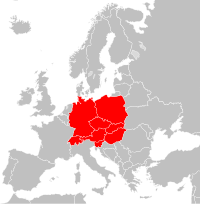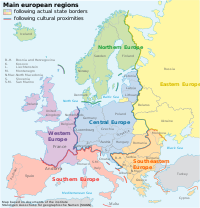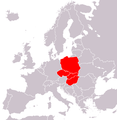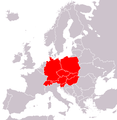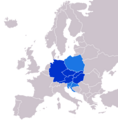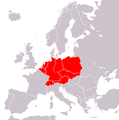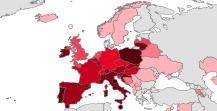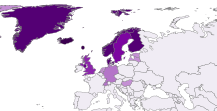Central Europe
Central Europe is a geographical region of Europe between Eastern, Southern, Western and Northern Europe.
Central Europe is known for its cultural diversity; however, countries in this region also share certain historical and cultural similarities.
Whilst the region is variously defined, it often includes Austria, Croatia, Czech Republic, Germany, Hungary, Lithuania, Poland, Slovakia, Slovenia and Switzerland. From the early 16th century until the early 18th century, parts of present-day Croatia and Hungary were under Ottoman rule. During the 17th century, the empire also occupied southern parts of present-day Slovakia. During the Early Modern period, the territories of Poland and Lithuania were part of the Polish-Lithuanian Commonwealth. Meanwhile, the Archduchy of Austria, the Kingdom of Bohemia (Czechia), the Duchy of Carniola (part of present-day Slovenia), the various German Principalities and the Old Swiss Confederacy were within the Holy Roman Empire. By the end of the 18th century, the Habsburg monarchy, a prominent power within the empire, came to reign over the territories of Austria, Bosnia and Herzegovina, Croatia, Czechia, Hungary, Slovakia and Slovenia, alongside parts of Serbia, Germany, Italy, Poland and Switzerland.
The countries that make up Central Europe have historically been, and in some cases continue to be, divided into either Eastern or Western Europe. After World War II, Europe was divided by the Iron Curtain into two parts, the capitalist Western Bloc and the communist Eastern Bloc, although Austria, Switzerland and Yugoslavia (encompassing the territories of present-day Croatia, Slovenia and various other Balkans nations) declared neutrality. The Berlin Wall was one of the most visible symbols of this division. Respectively, countries in Central Europe have historical, cultural and geopolitical ties with these wider regions of Europe.
Central Europe began a "strategic awakening" in the late 20th and early 21st century, with initiatives such as Central European Defence Cooperation, the Central European Initiative, Centrope, and the Visegrád Four Group. This awakening was accelerated by writers and other intellectuals, who recognized the societal paralysis of decaying dictatorships and felt compelled to speak up against Soviet oppression.
Historical perspective
Middle Ages and early modern period
In the early Middle Ages, Central Europe had a diverse landscape, with various ethnic groups inhabiting the region. Germanic tribes, among them the Franks, Alemans and Bavarians, were predominantly situated in the west, while Slavic tribes were predominantly in the east. However, the region encompassed a wide spectrum of additional tribes and communities.
From the late 6th century to the early 9th century, the area roughly corresponding to the Carpathian Basin was part of the Avar Khaganate, the realm of the Pannonian Avars. While the Avars dominated the east of what is now Austria, its north and south were under Germanic and Slavic influence, respectively. Meanwhile, the territories now comprising Germany and Switzerland were under the influence of the Merovingian dynasty, and later the Carolingian dynasty. Various Slavic tribes that inhabited eastern Central Europe established settlements during this period, primarily in present-day Croatia, Czechia, Poland, Slovakia and Slovenia. The territory of Lithuania was inhabited by Baltic tribes. Amongst them were the Samogitians, Aukštaitians and Curonians.
The Holy Roman Empire was founded at the turn of the 9th century, following the coronation of Charlemagne by Pope Leo III. At its inception, it incorporated present-day Germany and nearby regions, including parts of what is now Austria, Czechia, Slovenia and Switzerland. Three decades later, Great Moravia, centred in present-day Czechia and Slovakia, became one of the first West Slavic states to be founded in Central Europe. In the late 9th Century, the Hungarian tribes, originating in the Ural Mountains and Western Siberia, settled in the Carpathian Basin and established the Principality of Hungary.
The earliest recorded concept of Europe as a cultural sphere (instead of simply a geographic term) was formed by Alcuin of York in the late 8th century during the Carolingian Renaissance, limited to the territories that practised Western Christianity at the time.
Following the Christianization of various Central European countries, elements of cultural unity emerged within the region, specifically Catholicism and Latin. Eastern Europe, with the exclusion of eastern Central Europe, remained largely Eastern Orthodox, and was dominated by Byzantine cultural influence. After the East–West Schism in 1054, it developed cultural unity and resistance to Catholic and Protestant influence within the framework of the Eastern Orthodox Church, Church Slavonic language, and the Cyrillic alphabet.
- Frankish Empire and its tributaries in 814
- East Francia in 843
- Possible furthest extent of Great Moravia under Svatopluk I (870–894)
- Poland under the Piast Dynasty in 1000
- Kingdom of Hungary in 1190
- Holy Roman Empire in 1600
- Polish-Lithuanian Commonwealth and its fiefs in 1619
According to historian Jenő Szűcs, at the end of the first millennium Central Europe became influenced by Western European developments. Szűcs argued that between the 11th and 15th centuries, not only did Christianization influence the cultures within Central Europe, but well-defined social features were also implemented in the region based on Western characteristics. The keyword of Western social development after the turn of the millennium was the spread of Magdeburg rights in some cities and towns of Western Europe. These began to spread in the middle of the 13th century in Central European countries, bringing about self-governments of towns and counties.
In 1335, the Kings of Poland, Bohemia and Hungary and Croatia met in the castle of Visegrád and agreed to cooperate closely in the field of politics and commerce, inspiring the post-Cold War Visegrád Group.
In 1386, the Grand Duke of Lithuania became King of Poland through marriage to Queen Jadwiga of Poland. This led to the Union of Krewo, a personal union between the Grand Duchy of Lithuania and the Kingdom of Poland. This commenced an enduring political alliance between the two entities, laying the foundations for the later establishment of the Polish-Lithuanian Commonwealth in 1569.
Between the 15th and early 16th centuries, the territory of modern Croatia served as a significant maritime gateway of Central Europe, with its ports facilitating key trade routes between Central Europe and the Mediterranean. The Republic of Ragusa emerged as a prominent hub for cultural exchange during this time. Following the Ottoman and Habsburg wars of the 16th and 17th centuries, the Kingdom of Croatia, under Habsburg rule, began to regain its position as a significant trade route, restoring ports and revitalising commercial activity.
Before World War I

Before 1870, the industrialization that had started to develop in Northwestern and Central Europe and the United States did not extend in any significant way to the rest of the world. Even in Eastern Europe, industrialization lagged far behind. Russia, for example, remained largely rural and agricultural, and its autocratic rulers kept the peasants in serfdom. The concept of Central Europe was already known at the beginning of the 19th century, but it developed further and became an object of intensive interest towards the 20th century. However, the very first concept mixed science, politics, and economy – it was strictly connected with the aspirations of German states to dominate a part of European continent called Mitteleuropa. At the Frankfurt Parliament, which was established in the wake of the March Revolution of 1848, there were multiple competing ideas for the integration of German-speaking areas, including the mitteleuropäische Lösung (Central European Solution) propagated by Austria, which sought to merge the smaller German-speaking states with the multi-ethnic Habsburg Empire, but was opposed by Prussia and others. An imperialistic idea of Mitteleuropa also became popular in the German Empire established in 1871, which experienced intensive economic growth. The term was used when the Union of German Railway Administrations established the Mitteleuropäische Eisenbahn-Zeit (Central European Railway Time) time zone, which was applied by the railways from 1 June 1891 and was later widely adopted in civilian life, thus the time zone name shortened to the present-day Central European Time.
The German term denoting Central Europe was so fashionable that other languages started referring to it when indicating territories from Rhine to Vistula, or even Dnieper, and from the Baltic Sea to the Balkans. An example of this vision of Central Europe may be seen in Joseph Partsch's book of 1903.
On 21 January 1904, Mitteleuropäischer Wirtschaftsverein (Central European Economic Association) was established in Berlin with economic integration of Germany and Austria (with eventual extension to Switzerland, Belgium and the Netherlands) as its main aim. Another time, the term Central Europe became connected to the German plans of political, economic, and cultural domination. The "bible" of the concept was Friedrich Naumann's book Mitteleuropa in which he called for an economic federation to be established after World War I. Naumann's idea was that the federation would have at its centre in Germany and the Habsburg empire would incorporate all European nations outside the Triple Entente.[citation needed] The concept failed after the German defeat in World War I. The revival of the idea may be observed during the Hitler era.
Interwar period
The interwar period (1918–1938) brought a new geopolitical system, as well as economic and political problems, and the concept of Central Europe took on a different character. The centre of interest was moved to its eastern part – particularly to the countries that had (re)appeared on the map of Europe. Central Europe ceased to be the area of German aspiration to lead or dominate and became a territory of various integration movements aiming at resolving political, economic, and national problems of "new" states, being a way to face German and Soviet pressures. However, the conflict of interests was too big and neither Little Entente nor Intermarium (Międzymorze) ideas succeeded. Hungarian historian Ádám Magda wrote in her study Versailles System and Central Europe (2006): "Today we know that the bane of Central Europe was the Little Entente, military alliance of Czechoslovakia, Romania and Kingdom of Serbs, Croats and Slovenes (later Yugoslavia), created in 1921 not for Central Europe's cooperation nor to fight German expansion, but in a wrong perceived notion that a completely powerless Hungary must be kept down". The events preceding World War II in Europe—including the so-called Western betrayal/ Munich Agreement were very much enabled by the rising nationalism and ethnocentrism that typified that period.
The interwar period brought new elements to the concept of Central Europe. Before World War I, it embraced mainly German-speaking states, with non-German speaking territories being an area of intended German penetration and domination – German leadership was to be the 'natural' result of economic dominance. Post-war, the Eastern part of Central Europe was placed at the centre of the concept. At that time the scientists took an interest in the idea: the International Historical Congress in Brussels in 1923 was committed to Central Europe, and the 1933 Congress continued the discussions.
According to Emmanuel de Martonne, in 1927 the Central European countries included: Austria, Czechoslovakia, Germany, Hungary, Poland, Romania and Switzerland. The author uses both Human and Physical Geographical features to define Central Europe, but he doesn't take into account the legal development or the social, cultural, economic, and infrastructural developments in these countries.
The avant-garde movements of Central Europe contributed to the evolution of modernism, reaching its peak throughout the continent during the 1920s. The Sourcebook of Central European avantgards (Los Angeles County Museum of Art) contains primary documents of the avant-gardes in the territories of Austria, Germany, Poland, Czechoslovakia, Hungary, Romania and Yugoslavia from 1910 to 1930.
Mitteleuropa
With the dissolution of the Holy Roman Empire around 1800, there was a consolidation of power among the Habsburgs and Hohenzollerns as the two major states in the area. They had much in common and occasionally cooperated in various channels, but more often competed. One approach in the various attempts at cooperation, was the conception of a set of supposed common features and interests, and this idea led to the first discussions of a Mitteleuropa in the mid-nineteenth century, as espoused by Friedrich List and Karl Ludwig Bruck. These were mostly based on economic issues.
Mitteleuropa may refer to a historical concept or a contemporary German definition of Central Europe. As a historical concept, the German term Mitteleuropa (or alternatively its literal translation into English, Middle Europe) is an ambiguous German concept. It is sometimes used in English to refer to an area somewhat larger than most conceptions of 'Central Europe'; it refers to territories under Germanic cultural hegemony until World War I (usually excluding the Baltic countries north of East Prussia).[citation needed] According to Fritz Fischer Mitteleuropa was a scheme in the era of the Reich of 1871–1918 by which the old imperial elites had allegedly sought to build a system of German economic, military and political domination from the northern seas to the Near East and from the Low Countries through the steppes of Russia to the Caucasus. Later on, professor Fritz Epstein argued the threat of a Slavic "Drang nach Westen" (Western expansion) had been a major factor in the emergence of a Mitteleuropa ideology before the Reich of 1871 ever came into being.
In Germany the connotation was also sometimes linked to the pre-war German provinces east of the Oder-Neisse line.[citation needed]
The term "Mitteleuropa" conjures up negative historical associations among some elderly people, although the Germans have not played an exclusively negative role in the region. Most Central European Jews embraced the enlightened German humanistic culture of the 19th century. Jews of turn of the 20th century Central Europe became representatives of what many consider to be Central European culture at its best, though the Nazi conceptualisation of "Mitteleuropa" sought to destroy this culture. The term "Mitteleuropa" is widely used in German education and media without negative meaning, especially since the end of communism. Many people from the new states of Germany do not identify themselves as being part of Western Europe and therefore prefer the term "Mitteleuropa".[citation needed]
Central Europe during World War II
During World War II, Central Europe was largely occupied by Nazi Germany. Many areas were a battle area and were devastated. The mass murder of the Jews depopulated many of their centuries-old settlement areas or settled other people there and their culture was wiped out. Both Adolf Hitler and Joseph Stalin diametrically opposed the centuries-old Habsburg principles of "live and let live" with regard to ethnic groups, peoples, minorities, religions, cultures and languages and tried to assert their own ideologies and power interests in Central Europe. There were various Allied plans for state order in Central Europe for post-war. While Stalin tried to get as many states under his control as possible, Winston Churchill preferred a Central European Danube Confederation to counter these countries against Germany and Russia. There were also plans to add Bavaria and Württemberg to an enlarged Austria. There were also various resistance movements around Otto von Habsburg that pursued this goal. The group around the Austrian priest Heinrich Maier also planned in this direction, which also successfully helped the Allies to wage war by, among other things, forwarding production sites and plans for V-2 rockets, Tiger tanks and aircraft to the USA. Otto von Habsburg tried to relieve Austria, Czechoslovakia, Hungary and northern Yugoslavia (particularly the territories of present-day Croatia and Slovenia) from Nazi German, and Soviet, influence and control. There were various considerations to prevent German and Soviet power in Europe after the war. Churchill's idea of reaching the area around Vienna before the Russians via an operation from the Adriatic had not been approved by the Western Allied chiefs of staff. As a result of the military situation at the end of the war, Stalin's plans prevailed and much of Central Europe came under Russian control.
Central Europe behind the Iron Curtain

Following World War II, parts of Central Europe became part of the Eastern Bloc. The boundary between the two blocks was called the Iron Curtain.
The post-World War II period brought blocking of research on Central Europe in the Eastern Bloc countries, as its every result proved the dissimilarity of Central Europe, which was inconsistent with the Stalinist doctrine. On the other hand, the topic became popular in Western Europe and the United States, much of the research being carried out by immigrants from Central Europe. Following the Fall of Communism, publicists and historians in Central Europe, especially the anti-communist opposition, returned to their research.
According to Karl A. Sinnhuber (Central Europe: Mitteleuropa: Europe Centrale: An Analysis of a Geographical Term) most Central European states were unable to preserve their political independence and became Soviet satellites. Besides Switzerland and Austria, only the marginal European states of Cyprus, Finland, Malta, Sweden and Yugoslavia preserved their political sovereignty to a certain degree, being left out of any military alliances in Europe.
The opening of the Iron Curtain between Austria and Hungary at the Pan-European Picnic on 19 August 1989 then set in motion a peaceful chain reaction, at the end of which there was no longer an East Germany and the Eastern Bloc had disintegrated. It was the largest escape movement from East Germany since the Berlin Wall was built in 1961. After the picnic, which was based on an idea by Otto von Habsburg to test the reaction of the USSR and Mikhail Gorbachev to an opening of the border, tens of thousands of media-informed East Germans set off for Hungary. The leadership of the GDR in East Berlin did not dare to completely block the borders of their own country and the USSR did not respond at all. This broke the bracket of the Eastern Bloc and Central Europe subsequently became free from communism.
Roles
According to American professor Ronald Tiersky, the 1991 summit held in Visegrád attended by the Polish, Hungarian and Czechoslovak presidents was hailed at the time as a major breakthrough in Central European cooperation, but the Visegrád Group became a vehicle for coordinating Central Europe's road to the European Union, while development of closer ties within the region languished.
American professor Peter J. Katzenstein described Central Europe as a way station in a Europeanization process that marks the transformation process of the Visegrád Group countries in different, though comparable ways. According to him, in Germany's contemporary public discourse "Central European identity" refers to the civilizational divide between Catholicism and Eastern Orthodoxy. He says there is no precise, uncontestable way to decide whether Lithuania, Latvia, Estonia, Serbia, Croatia, Slovenia, Romania, or Bulgaria are parts of Central Europe.
Definitions

The issue of how to name and define the Central European area is subject to debates. Very often, the definition depends on the nationality and historical perspective of its author. The concept of "Central Europe" appeared in the 19th century. It was understood as a contact zone between the Southern and Northern areas, and later the Eastern and Western areas, of Europe. Thinkers portrayed "Central Europe" either as a separate region, or a buffer zone between these regions.
In the early nineteenth century, the terms "Middle" or "Central" Europe (known as "Mitteleuropa" in German and "Europe centrale" in French) were introduced in geographical scholarship in both German and French languages. At first, these terms were linked to the regions spanning from the Pyrenees to the Danube, which, according to German authors, could be united under German authority. However, after the Franco-Prussian war of 1870, the French began to exclude France from this area, and later the Germans also adopted this perspective by the end of World War I.
The concept of "Central" or "Middle Europe", understood as a region with German influence, lost a significant part of its popularity after WWI and was completely dismissed after WWII. Two defeats of Germany in the world wars, combined with the division of Germany, an almost complete disappearance of German-speaking communities in these countries, and the Communist-led isolation of Czechoslovakia, Hungary, Lithuania, Poland and Yugoslavia from the Western world, turned the concept of "Central/Middle Europe" into an anachronism. On the other side, the non-German areas of Central Europe were almost universally regarded as "Eastern European" primarily associated with the Soviet sphere of influence in the late 1940s–1980s.
For the most part, this geographical framework lost its attraction after the end of the Cold War. A number of Post-Communist countries rather re-branded themselves in the 1990s as "Central European.", while avoiding the stained wording of "Middle Europe," which they associated with German influence in the region. This reinvented concept of "Central Europe" excluded Germany, Austria and Switzerland, reducing its coverage chiefly to Poland, Czechia, Slovakia, Hungary, Lithuania and Yugoslavia.
Academic
The main proposed regional definitions, gathered by Polish historian Jerzy Kłoczowski, include:
- West-Central and East-Central Europe – this conception, presented in 1950, distinguishes two regions in Central Europe: German West-Centre, with imperial tradition of the Reich, and the East-Centre covered by variety of nations from Finland to Greece, placed between great empires of Scandinavia, Germany, Italy and the Soviet Union.
- Central Europe as the area of cultural heritage of the Polish–Lithuanian Commonwealth – Ukrainian, Belarusian and Lithuanian historians, in cooperation (since 1990) with Polish historians, insist on the importance of the concept.
- Central Europe as a region connected to the Western civilisation since the foundation of the local states and churches, including countries such as the Polish–Lithuanian Commonwealth, Kingdom of Croatia, Holy Roman Empire, later German Empire and the Habsburg monarchy, the Kingdom of Hungary and the Crown of Bohemia. Central Europe understood in this way borders on Russia and South-Eastern Europe, but the exact frontier of the region is difficult to determine.
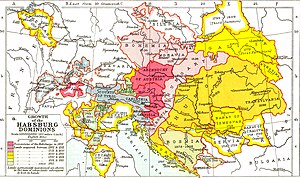
- Central Europe as the area of the former Habsburg Empire[citation needed] – a concept which is popular in regions along the river Danube[citation needed]: Austria, the Czech Republic and Slovakia, Slovenia, large parts of Bosnia, Croatia and Romania[dubious ]. Also, smaller parts of Poland, Serbia[dubious ][citation needed] and Ukraine[dubious ].
- A concept underlining the links connecting Belarus, Moldova and Ukraine with Russia and treating the Russian Empire together with the whole Slavic Orthodox population as one entity – this position is taken by the Russian historiography.[citation needed][dubious ].
- A concept putting the accent on links with the West[citation needed][dubious ], especially from the 19th century and the grand period of liberation and formation of Nation-states – this idea is represented by the South-Eastern states, which prefer the enlarged concept of the "East Centre" expressing their links with Western culture[dubious ].[citation needed]
Former University of Vienna professor Lonnie R. Johnson points out criteria to distinguish Central Europe from Western, Northern, Eastern and Southern Europe:[90]
- One criterion for defining Central Europe is the frontiers of medieval empires and kingdoms that largely correspond to the religious frontiers between the Catholic West and the Orthodox East. The pagans of Central Europe were converted to Catholicism while in Southeastern and Eastern Europe they were brought into the fold of the Eastern Orthodox Church.
- Multinational empires were a characteristic of Central Europe. Hungary and Poland, small and medium-size states today, were empires during their early histories. The historical Kingdom of Hungary was until 1918 three times larger than present-day Hungary, while Polish-Lithuanian Commonwealth was the largest state in Europe in the 16th century. Both these kingdoms housed a wide variety of different peoples.
He also thinks that Central Europe is a dynamic historical concept, not a static spatial one. For example, a fair share of Belarus and western Ukraine are in Eastern Europe today, but 240 years ago they were in the Polish–Lithuanian Commonwealth.
Johnson's study on Central Europe received acclaim and positive reviews in the scientific community. However, according to Romanian researcher Maria Bucur this very ambitious project suffers from the weaknesses imposed by its scope (almost 1600 years of history).
Encyclopedias, gazetteers, dictionaries
The World Factbook defines Central Europe as: Austria, Czechia, Germany, Hungary, Liechtenstein, Poland, Slovakia, Slovenia and Switzerland. The Columbia Encyclopedia includes: Austria, Czechia, Germany, Hungary, Latvia, Lithuania, Poland, Slovakia and Switzerland. While it does not have a single article defining Central Europe, Encyclopædia Britannica includes the following countries in Central Europe in one or more of its articles: Austria, Bosnia and Herzegovina, Croatia, Czechia, Germany, Hungary, Poland, Slovakia, Slovenia and Switzerland.
The German Encyclopaedia Meyers Grosses Taschenlexikon (Meyers Big Pocket Encyclopedia), 1999, defines Central Europe as the central part of Europe with no precise borders to the East and West. The term is mostly used to denominate the territory between the Schelde to Vistula and from the Danube to the Moravian Gate. Usually the countries considered to be Central European are Austria, Croatia, Czechia, Germany, Hungary, Liechtenstein, Lithuania, Poland, Slovakia, Slovenia and Switzerland.
According to Meyers Enzyklopädisches Lexikon, Central Europe is a part of Europe composed of Austria, Belgium, the Czech Republic, Slovakia, Germany, Hungary, Luxembourg, Netherlands, Poland, Romania and Switzerland, and northern marginal regions of Italy and Yugoslavia (northern states – Croatia and Slovenia), as well as northeastern France.
The German Ständige Ausschuss für geographische Namen (Standing Committee on Geographical Names), which develops and recommends rules for the uniform use of geographical names, proposes two sets of boundaries. The first follows international borders of current countries. The second subdivides and includes some countries based on cultural criteria. In comparison to some other definitions, it is broader, including Luxembourg, Estonia, Latvia, and in the second sense, parts of Russia, Belarus, Ukraine, Romania, Serbia, Italy, and France.
Geographical

There is no general agreement either on what geographic area constitutes Central Europe, nor on how to further subdivide it geographically.
At times, the term "Central Europe" denotes a geographic definition as the Danube region in the heart of the continent, including the language and culture areas which are today included in the states of Bulgaria, Croatia, the Czech Republic, Hungary, Moldova, Poland, Romania, Serbia, Slovakia, Slovenia and usually also Austria and Germany.
Governmental and standards organisations
The terminology EU11 countries refer the Central, Eastern and Baltic European member states which accessed in 2004 and after: in 2004 Czech Republic, Estonia, Latvia, Lithuania, Hungary, Poland, Slovenia, and Slovakia; in 2007 Bulgaria, Romania; and in 2013 Croatia.
Map gallery
- Central Europe according to Peter J. Katzenstein (1997):The Visegrád Group countries are referred to as Central Europe in the book.Countries for which there is no precise, uncontestable way to decide whether they are parts of Central Europe or not
- According to The Economist and Ronald Tiersky, a strict definition of Central Europe means the Visegrád Group.
- Map of Central Europe, according to Lonnie R. Johnson (2011):Countries considered to be Central European only in the broader sense of the term
- Central European countries in Encarta Encyclopedia (2009):Central European countriesSlovenia in "south central Europe"
- The Central European Countries according to Meyers Grosses Taschenlexikon (1999):Countries usually considered Central EuropeanCentral European countries in the broader sense of the termCountries occasionally considered to be Central European
- Middle Europe (Brockhaus Enzyklopädie, 1998)
- Central Europe according to Swansea University professors Robert Bideleux and Ian Jeffries (1998)
- Central Europe, as defined by E. Schenk (1950)
- Central Europe, according to Alice F. A. Mutton in Central Europe. A Regional and Human Geography (1961)
- Central Europe according to Meyers Enzyklopaedisches Lexikon (1980)
States

The choice of states that make up Central Europe is an ongoing source of controversy. Although views on which countries belong to Central Europe are vastly varied, according to many sources (see section Definitions) the region includes some or all of the states listed in the sections below:
- Austria
- Croatia[90]
- Czech Republic
- Germany
- Hungary
- Lithuania
- Poland
- Slovakia
- Slovenia
- Switzerland
Depending on the context, Central European countries are sometimes not seen as a specific group, but sorted as either Eastern or Western European countries. In this case Austria, Germany and Switzerland are often placed in Western Europe, while Croatia, the Czech Republic, Hungary, Lithuania, Poland, Slovakia and Slovenia are placed in Eastern Europe.
Croatia is alternatively placed in Southeastern Europe. Additionally, Hungary and Slovenia are sometimes included in the region.
Lithuania is alternatively placed in Northeastern Europe.

Other countries and regions
Some sources also add regions of neighbouring countries for historical reasons, or based on geographical and/or cultural reasons:
- Bosnia and Herzegovina (as a former part of the Habsburg monarchy, placed in Southern or Southeast Europe)
- Estonia (considered to have been part of 'Mitteleuropa', alternatively placed in Eastern, Northeastern or Northern Europe)
- Italy (South Tyrol, Trentino, Trieste and Gorizia, Friuli, Lombardy, and Veneto or all of Northern Italy)[failed verification]
- Latvia (considered to have been part of 'Mitteleuropa')
- Romania (Transylvania, along with Banat, Crișana, Maramureș, Bukovina and Muntenia along with Oltenia)
- Russia (Kaliningrad Oblast)
- Serbia (primarily Vojvodina and Northern Belgrade, alternatively placed in Southeast Europe)[145]
- Ukraine (Transcarpathia, Galicia and Northern Bukovina)
Geography
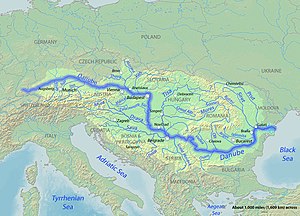
Geography defines Central Europe's natural borders with the neighbouring regions to the north across the Baltic Sea, namely Northern Europe (or Scandinavia), and to the south across the Alps, the Apennine peninsula (or Italy), and the Balkan peninsula across the Soča–Krka–Sava–Danube line. The borders to Western Europe and Eastern Europe are geographically less defined, and for this reason the cultural and historical boundaries migrate more easily west–east than south–north. The river Rhine, which runs south–north through Western Germany, is an exception.[original research?]
Southwards, the Pannonian Plain is bounded by the rivers Sava and Danube – and their respective floodplains. The Pannonian Plain stretches over the following countries: Austria, Croatia, Hungary, Romania, Serbia, Slovakia and Slovenia, and touches borders of Bosnia and Herzegovina and Ukraine ("peri- Pannonian states").
As the southeastern division of the Eastern Alps, the Dinaric Alps extend for 650 kilometres along the coast of the Adriatic Sea (northwest-southeast), from the Julian Alps in the northwest down to the Šar-Korab massif, north–south. According to the Freie Universität Berlin, this mountain chain is classified as South Central European. The city of Trieste in this area, for example, expressly sees itself as a città mitteleuropea. This is particularly because it lies at the interface between the Latin, Slavic, Germanic, Greek and Jewish culture on the one hand and the geographical area of the Mediterranean and the Alps on the other. A geographical and cultural assignment is made.
The Central European flora region stretches from Central France (the Massif Central) to the Northern Balkans, Central Romania (Carpathians) and Southern Scandinavia.
Demography
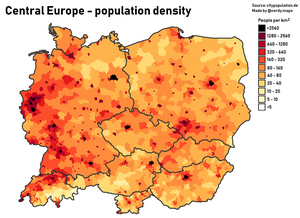
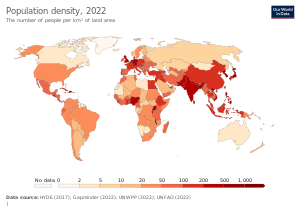
Central Europe is one of the continent's most populous regions. It includes countries of varied sizes, ranging from tiny Liechtenstein to Germany, the second largest European country by population. Demographic figures for countries entirely located within notion of Central Europe ("the core countries") number around 165 million people, out of which around 82 million are residents of Germany. Other populations include: Poland with around 38.5 million residents, Czech Republic at 10.5 million, Hungary at 10 million, Austria with 8.8 million, Switzerland with 8.5 million, Slovakia at 5.4 million, Slovenia with 2.1 million and Liechtenstein at a bit less than 40,000.
If the countries which are sometimes also included in Central Europe were counted in, partially or in whole – Croatia (4.3 million), Romania (20 million), Lithuania (2.9 million), Latvia (2 million), Estonia (1.3 million), Serbia (7.1 million) – it would contribute to the rise of between 25 and 35 million, depending on whether regional or integral approach was used. If smaller, western and eastern historical parts of Central Europe would be included in the demographic corpus, further 20 million people of different nationalities would also be added in the overall count, it would surpass the 200 million people figure.
Economy
Currencies
Currently, the members of the Eurozone include Austria, Croatia, Germany, Luxembourg, Slovakia, and Slovenia. The Czech Republic, Hungary and Poland use their own currencies (koruna, forint, Polish złoty, respectively), but are obliged to adopt the Euro. Switzerland uses its own currency (Swiss franc), as does Serbia (dinar) and Romania (Romanian leu).
Human Development Index
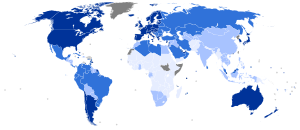
Very High | Low |
High | Data unavailable |
Medium |
In 2018, Switzerland topped the HDI list among Central European countries, also ranking No. 2 in the world. Serbia rounded out the list at No. 11 (67 world).
Globalisation
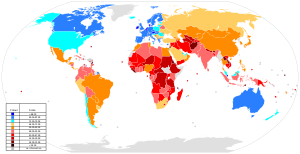
The index of globalization in Central European countries (2016 data): Switzerland topped this list as well (#1 world).
Prosperity Index
Legatum Prosperity Index demonstrates an average and high level of prosperity in Central Europe (2018 data). Switzerland topped the index (#4 world).
Corruption

| 90–100 | 60–69 | 30–39 | 0–9 |
| 80–89 | 50–59 | 20–29 | No information |
| 70–79 | 40–49 | 10–19 |
Most countries in Central Europe tend to score above the average in the Corruption Perceptions Index (2018 data), led by Switzerland, Germany, and Austria.
Rail
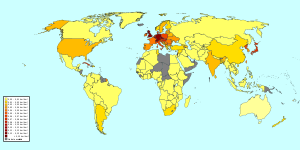
Central Europe contains the continent's earliest railway systems, whose greatest expansion was recorded in Austro-Hungarian and German territories between 1860-1870s. By the mid-19th century Berlin, Vienna, and Buda/Pest were focal points for network lines connecting industrial areas of Saxony, Silesia, Bohemia, Moravia and Lower Austria with the Baltic (Kiel, Szczecin) and Adriatic (Rijeka, Trieste).[167] By 1913, the combined length of the railway tracks of the Austrian Empire and Kingdom of Hungary reached 43,280 kilometres (26,890 miles).
Rail infrastructure in Central Europe remains the densest in the world. Railway density, with total length of lines operated (km) per 1,000 km2, is the highest in the Czech Republic (198.6), Poland (121.0), Slovenia (108.0), Germany (105.5), Hungary (98.7), Serbia (49.2), Slovakia (73.9) and Croatia (72.5).
River transport and canals
Before the first railroads appeared in the 1840s, river transport constituted the main means of communication and trade.[167] Earliest canals included Plauen Canal (1745), Finow Canal, and also Bega Canal (1710) which connected Timișoara to Novi Sad and Belgrade via Danube.[167] The most significant achievement in this regard was the facilitation of navigability on Danube from the Black sea to Ulm in the 19th century.
The economies of Austria, Croatia, the Czech Republic, Germany, Hungary, Poland, Slovakia, Slovenia and Switzerland tend to demonstrate high complexity. Industrialisation reached Central Europe relatively early: the Czech lands by 1797,
The industrialization of the cities of Romania and Serbia and Serbia started in the interwar period, and did not make significant progress until the post ww2 era.
Agriculture
Central European countries are some of the most significant food producers in the world. Germany is the world's largest hops producer with 34.27% share in 2010, third producer of rye and barley, 5th rapeseed producer, sixth largest milk producer, and fifth largest potato producer. Poland is the world's largest triticale producer, second largest producer of raspberries, currants, third largest of rye, the fifth apple and buckwheat producer, and seventh largest producer of potatoes. Czech Republic is world's fourth largest hops producer and 8th producer of triticale. Hungary is world's fifth hops and seventh largest triticale producer. Serbia is world's second largest producer of plums and second largest of raspberries. Slovenia is world's sixth hops producer.
Business
Central European business has a regional organisation, Central European Business Association (CEBA), founded in 1996 in New York as a non-profit organization dedicated to promoting business opportunities within Central Europe and supporting the advancement of professionals in America with a Central European background.
Tourism
Central European countries, especially Austria, Croatia, Germany and Switzerland are some of the most competitive tourism destinations.
Education
Languages
Education performance
Student performance has varied across Central Europe, according to the Programme for International Student Assessment. In the 2012 study, countries scored medium, below or over the average scores in three fields studied.
Higher education

Universities
The first university established east of France and north of the Alps was in Prague in 1348 by Charles IV, Holy Roman Emperor. The Charles University was modeled upon the University of Paris and initially included the faculty of law, medicine, philosophy, and theology.
Central European University

In 1991, Ernest Gellner proposed the establishment of a truly Central European institution of higher learning in Prague (1991–1995). Eventually, the Central European University (CEU) project was taken on and financially supported by the Hungarian philanthropist George Soros, who had provided an endowment of US$880 million, making the university one of the wealthiest in Europe. Over its 30-year history CEU has become one of the most internationally diverse and recognisable universities in the world. For example, as of 2019, 1217 students were enrolled in the university, of which 962 were international students, making the student body the fourth most international in the world. CEU offers highly selective programs with a student to faculty ratio of 7:1. In 2021, the admission rate into its programs was 13%. CEU has thus become a leading global university in Europe promoting a distinctively Central European perspective while emphasizing academic rigor, applied research, and academic honesty and integrity. CEU is a founding member of CIVICCA, a group of prestigious European higher education institutions in the social sciences, humanities, business management and public policy, such as Sciences Po (France), The London School of Economics and Political Science (UK), Bocconi University (Italy) and the Stockholm School of Economics (Sweden). In 2019, Central European University leadership announced their preparatory work on moving CEU to Vienna due to legal constraints against academic freedom in Hungary.
Culture and society
Research
Research centres of Central European literature include Harvard University (Cambridge, MA), Purdue University, and Central European Studies Programme (CESP), Masaryk University, Brno, Czech Republic.
Architecture
Religion
Central European countries are mostly Catholic (Austria, Croatia, Liechtenstein, Lithuania, Poland, Slovakia and Slovenia) or historically both Catholic and Protestant (the Czech Republic, Germany, Hungary and Switzerland). Large Protestant groups include Lutheran, Calvinist, and the Unity of the Brethren affiliates. Significant populations of Eastern Catholicism and Old Catholicism are also prevalent throughout Central Europe. Orthodox Christianity is a minority denomination observed to varying extents across Central Europe.
Central Europe has been the center of the Protestant movement for centuries, with the majority of Protestants suppressed and annihilated during the Counterreformation.
Historically, people in Bohemia in today's Czech Republic were one of the very first Protestants in Europe. As a result of the Thirty Years' War following the Bohemian Revolt, many Czechs were either killed, executed (see for Old Town Square execution), forcibly turned into Roman Catholics, or emigrated to Scandinavia and the Low Countries. In the aftermath of the Thirty Years' War, the number of inhabitants in the Kingdom of Bohemia decreased from three million to only 800,000 due to multiple factors, including devastating ongoing battles such as the significant Battle of White Mountain and the Battle of Prague (1648). However, in recent years, most Czechs report as overwhelmingly non-religious, with some describing themselves as Catholic (10.3%).
Before the Holocaust (1941–45), there was also a sizeable Ashkenazi Jewish community in the region, numbering approximately 16.7 million people. Poland, Lithuania and Hungary had the largest Jewish populations in Europe as a percentage of their total populations, with Jews constituting 9.5% of the Polish population in 1933.
Certain countries in Central Europe, particularly the Czech Republic, Germany and Switzerland have sizeable atheist and non-religious populations. In 2021, 48% of the Czech population declared that they had no religion. In 2022, 43.8% of the German population declared that they had no religion. Meanwhile, 33.5% of the Swiss population stated that they were not affiliated with any religion.
Cuisine
Central European cuisine has evolved over centuries due to social and political change and is generally diverse. However, the national cuisines of western Central Europe share notable similarities, as do the cuisines of eastern Central Europe. Sausages and cheeses are popular in most of Central Europe, with the earliest evidence of cheesemaking in the archaeological record dates back to 5,500 BCE (Kuyavia region, Poland). However, they are not a prominent feature of Hungarian and Slovak cuisine. Other popular food items in Central Europe include soups, stews, pickled and fermented vegetables. Schnitzel, goulash and cabbage rolls are popular in the region.
Another common feature among Central European cuisines, particularly Austrian, Croatian, Lithuanian, Slovenian and Swiss cuisine, is the use of wild ingredients in traditional dishes, spanning from wild herbs to mushrooms and berries. Beer consumption is also prominent in parts of Central Europe, where the Czech Republic has the highest beer consumption per capita globally, followed by Austria, with Germany coming 4th. The cuisines of Central European countries that are included in broader definitions of Eastern Europe share similarities and traditions with other Eastern European cuisines. This is particularly evident in the cuisines of Lithuania and Poland, which feature dishes like borscht, pierogi and sour rye soup.
Human rights
Generally, the countries in the region have been progressive on the issue of human rights: death penalty is illegal in all of them, corporal punishment is outlawed in most of them and people of both genders can vote in elections. However, Central European countries are divided on the subject of same-sex marriage and abortion. Austria, the Czech Republic, Germany, and Poland also have a history of participation in the CIA's extraordinary rendition and detention program, according to the Open Society Foundations.
Literature
Regional writing tradition revolves around the turbulent history of the region, as well as its cultural diversity. Its existence is sometimes challenged. Specific courses on Central European literature are taught at Stanford University, Harvard University and Jagiellonian University as well as cultural magazines dedicated to regional literature. Angelus Central European Literature Award is an award worth 150,000.00 PLN (about $50,000 or £30,000) for writers originating from the region. Likewise, the Vilenica International Literary Prize is awarded to a Central European author for "outstanding achievements in the field of literature and essay writing".
Media
Sport
There is a number of Central European Sport events and leagues. They include:
- Central European Tour Miskolc GP (Hungary)*
- Central European Tour Budapest GP (Hungary)
- 2008 Central Europe Rally (Romania and Hungary)*
- 2023 Central Europe Rally (Germany, Austria and Czech Republic)
- Central European Football League (Austria, Croatia, Hungary, Serbia, Slovakia, Slovenia and Turkey)
- Central European International Cup (Austria, Czechoslovakia, Hungary, Italy, Poland, Switzerland and Yugoslavia; 1927–1960)
- Central Europe Throwdown*
Football is one of the most popular sports. Countries of Central Europe hosted several major competitions. Germany hosted two FIFA World Cups (1974 and 2006) and the UEFA Euro 1988. Yugoslavia hosted the UEFA Euro 1976 before the competition expanded to 8 teams. Recently, the 2008 and 2012 UEFA European Championships were held in Austria & Switzerland and Poland & Ukraine respectively. The UEFA Euro 2024 will be hosted by Germany.
Politics
Organisations
Central Europe is a birthplace of regional political organisations:
- Visegrád Group
- Central European Defence Cooperation
- Three Seas Initiative
- Centrope
- Central European Initiative
- Middleeuropean Initiative
- Central European Free Trade Agreement
- Central European Initiative
- CEFTA founding states
- CEFTA members in 2003, before joining the EU
- Current CEFTA members
Democracy Index

Central Europe is a home to some of world's oldest democracies. However, most of them have been impacted by totalitarianism, particularly Fascism and Nazism. Germany and Italy occupied all Central European countries, except Switzerland. In all occupied countries, the Axis powers suspended democracy and installed puppet regimes loyal to the occupation forces. Also, they forced conquered countries to apply racial laws and formed military forces for helping German and Italian struggle against Communists. After World War II, almost the whole of Central Europe (the Eastern and Middle part) had been transformed into communist states, most of which had been occupied and later allied with the Soviet Union, often against their will through forged referendum (e.g., Polish people's referendum in 1946) or force (northeast Germany, Poland, Hungary et alia). Nevertheless, these experiences have been dealt in most of them. Most of Central European countries score very highly in the Democracy Index.
Global Peace Index
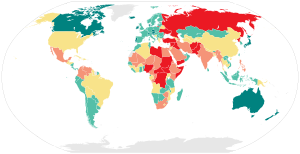
In spite of its turbulent history, Central Europe is currently one of world's safest regions. Most Central European countries are in top 20%.
Central European Time
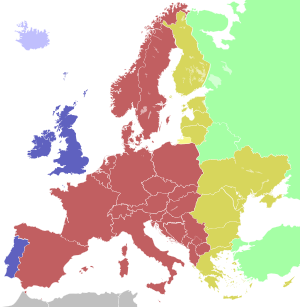
The time zone is a standard time which is 1 hour ahead of Coordinated Universal Time. Countries using CET include:
- Albania
- Andorra
- Austria
- Belgium
- Bosnia and Herzegovina
- Croatia
- Czech Republic
- Denmark
- France
- Germany
- Hungary
- Italy
- Luxembourg
- Monaco
- Montenegro
- Netherlands
- North Macedonia
- Norway
- Poland
- San Marino
- Slovakia
- Slovenia
- Serbia
- Sweden
- Switzerland
- Vatican City
In popular culture
Central Europe is mentioned in the 35th episode of Lovejoy, entitled "The Prague Sun", filmed in 1992. While walking over the well-regarded and renowned Charles Bridge in Prague, the main character, Lovejoy, says: "I've never been to Prague before. Well, it is one of the great unspoiled cities in Central Europe. Notice: I said: 'Central', not 'Eastern'! The Czechs are a bit funny about that, they think of Eastern Europeans as turnip heads."
Wes Anderson's Oscar-winning film The Grand Budapest Hotel depicts a fictional grand hotel located somewhere in Central Europe which is in actuality modeled on the Grandhotel Pupp in Karlovy Vary in the Czech Republic. The film is a celebration of the 1920s and 1930s Central Europe with its artistic splendor and societal sensibilities.
See also
References
Citations
- Wiki English
 Definitions from Wiktionary
Definitions from Wiktionary - Wiki English
 Media from Commons
Media from Commons - Wiki English
 Quotations from Wikiquote
Quotations from Wikiquote - Wiki English
 Travel information from Wikivoyage
Travel information from Wikivoyage
- Journal of East Central Europe
- Central European Political Science Association's journal "Politics in Central Europe"
- CEU Political Science Journal (PSJ)
- Central European Journal of International and Security Studies
- Central European Political Studies Review
- The Centrope region
- Maps of Europe and European countries
- CENTRAL EUROPE 2020 Archived 15 October 2015 at the Wayback Machine
- Central Europe Economy
- UNHCR Office for Central Europe
This article uses material from the Wikipedia English article Central Europe, which is released under the Creative Commons Attribution-ShareAlike 3.0 license ("CC BY-SA 3.0"); additional terms may apply (view authors). Content is available under CC BY-SA 4.0 unless otherwise noted. Images, videos and audio are available under their respective licenses.
®Wikipedia is a registered trademark of the Wiki Foundation, Inc. Wiki English (DUHOCTRUNGQUOC.VN) is an independent company and has no affiliation with Wiki Foundation.
